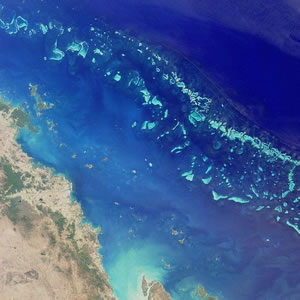The Great Barrier Reef is the largest structure on Earth that has been made by living things.
It is an enormous coral reef system that lies along a wide continental shelf of limestone rock along the eastern seaboard of Queensland, Australia.
The reef is around 2,010km (1,250mi) long. Both the continental shelf and the reef are at their widest - around 320km (200mi) in the southern reaches, near Cape Manifold.
 Ninety percent of the Great Barrier Reef lies underwater. An archipelago of islands, shoals and reefs is separated by twisting channels that can only be navigated safely by small craft.
Ninety percent of the Great Barrier Reef lies underwater. An archipelago of islands, shoals and reefs is separated by twisting channels that can only be navigated safely by small craft.
In some places, the coral is so extensive that people can wade across what appears to be huge stretches of open water without ever needing to swim.
The Great Barrier Reef is famous for its variety of shapes and colors. Multiple branches, giant fans and iridescent tentacles of corals can be seen along with vividly patterned fish, crustaceans and worms.
The Corals
Hard corals, simple animals that are related to sea anemones, average about 5mm (0.2in) in diameter. They have white skeletons that are rich in calcium carbonate. The skeletons and are covered with soft, variously shaped and brightly colored tissue.
The corals contain single-celled algae called zooxanthellae that allow them to secrete calcium carbonate and build reefs.
Below 55m (180ft), these algae are unable to acquire the light they need for photosynthesis. Therefore, coral reefs will only form in shallow water.
Corals will only colonize into reefs if the water maintains a year-round temperature not less than 20°C (68°F).
Thus, the clear, salty, well-oxygenated waters above the Great Barrier Reef provide the perfect conditions for coral reef-building.